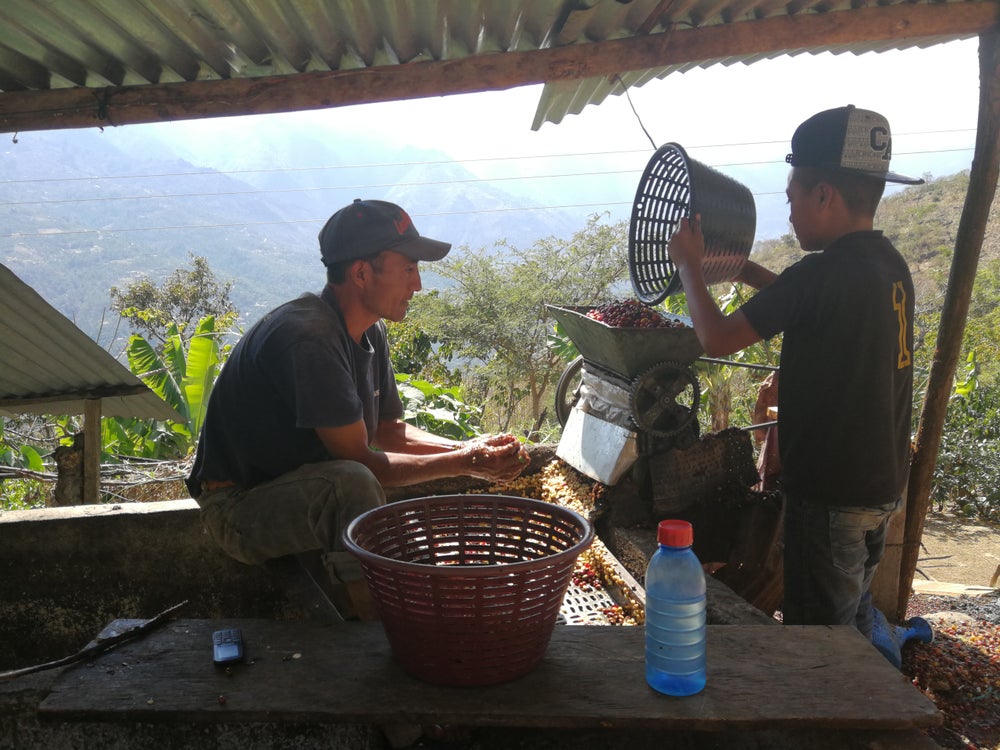About This Coffee
Huehuetenango—where about 75% of the population are indigenous Maya—has the largest population of Mam people. The Mam can trace their history to at least 200 A.D. when, as a kingdom within the Mayan Empire, the were centered around their capital city of Zaculeu, near what is now the outskirts of Huehuetenango City.
When Jesuit priests brought coffee to Guatemala in the 1770s, it soon spread to Huehuetenango, where it became an essential part of Mam culture. Roasted on the same pans used to make tortillas, coffee became an integral part of the morning meal. Coffee also became a high value tool for bartering and gifts for special occasions such as baptisms, marriage and wishing others well.
Cultivation
Mam have been farming the land in Huehuetenango for thousands of years. Their traditional farming techniques include using the waste product from their sheep for organic fertilizer, rotating land to give the soil time to recover and harvesting communally. Mam farmers have also traditionally planted a wide variety of crops in a way that best utilizes the sharp altitude changes along Huehuetenango’s steep slopes.
Thanks to the region’s unique location that brings it hot air from the west and cool air from the north, farms in Huehuetenango are able to cultivate coffee at heights that often exceed 2,000 meters above sea level. These conditions help produce the dazzling acidity and lively fruit notes so beloved in coffees from the region.
Harvest & Post-Harvest
Due to its remoteness, most producers in Huehuetenango process their own coffee. Farmers selectively handpick cherry and pulp it on their farms, usually with small hand-powered or electric drum pulpers. After fermenting, parchment is agitated to remove remaining mucilage and washed with clean water. All water used during pulping and washing will be filtered – usually through earthen holes – so that the organic solids do not contaminate local waterways. Farmers typically lay parchment to dry on raised beds that are stacked on top of each other to maximize space. Patios are also frequently used.
About Huehuetenango
Huehuetenango is well-known for its high altitude and consistent weather patterns. The region lies at a nexus of hot air sweeping eastwards from the Plains of Tehuantepec in Oaxaca, Mexico and cool air rushing down from the Cuchumantanes Mountains. The meeting of this hot and cold air creates a microclimate that keeps frost in check and enables coffee cultivation at higher altitudes. Coffee production at 2,000 meters above sea level here is common. These conditions are perfect for producing the sparkling acidity and distinctive fruit flavors of the region.
Coffee in Guatemala
Guatemala boasts a variety of growing regions and conditions that produce spectacular coffees. Today, the country is revered as a producer of some of the most flavorful and nuanced cups worldwide. We are proud to work with several exceptional in-country partners to bring these coffees to market.
The Guatemalan coffee industry experienced a major setback with the 2010 appearance of Coffee Leaf Rust (CLR) in Latin America. The epidemic peaked in severity in 2012, and though CLR continues to affect some farms, Guatemala continues to produce high-quality, record-breaking coffees. In 2017, new and varied processing methods pushed prices at the Guatemalan Cup of Excellence contest to record highs.
The quality of coffee being produced in Guatemala is increasing, overall, due to the diversity of the industry’s producers. There are more and more small holder farmers producing exceptional coffee at high altitudes. Cooperatives are becoming more appealing to so many smallholders because they often offer farmers financing and other support for improving their farming and processing and are frequently able to offer higher prices for cherry than middlemen. Many cooperatives have initiated quality improvement training for farmer members and are becoming more adept at helping members market their coffee as specialty.

